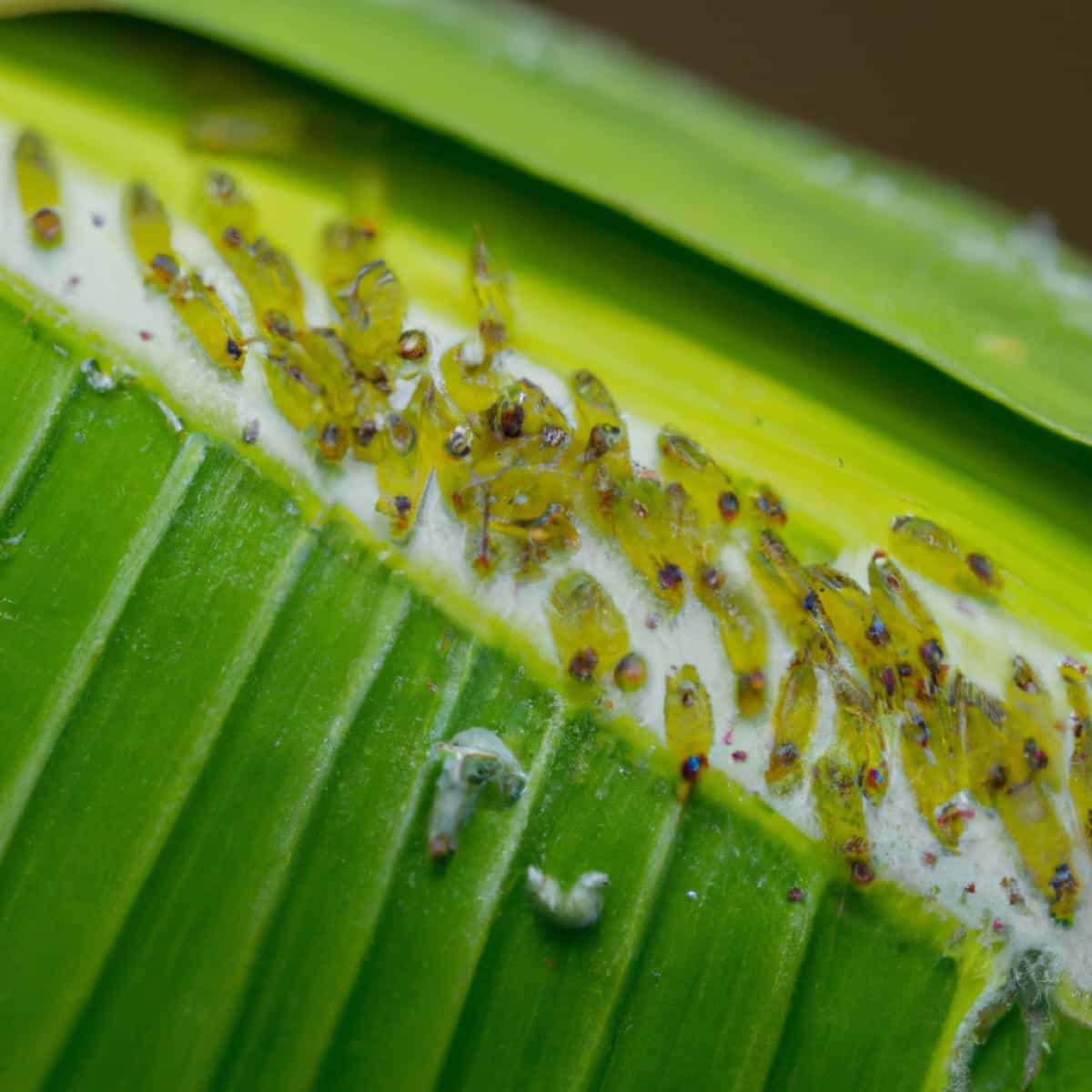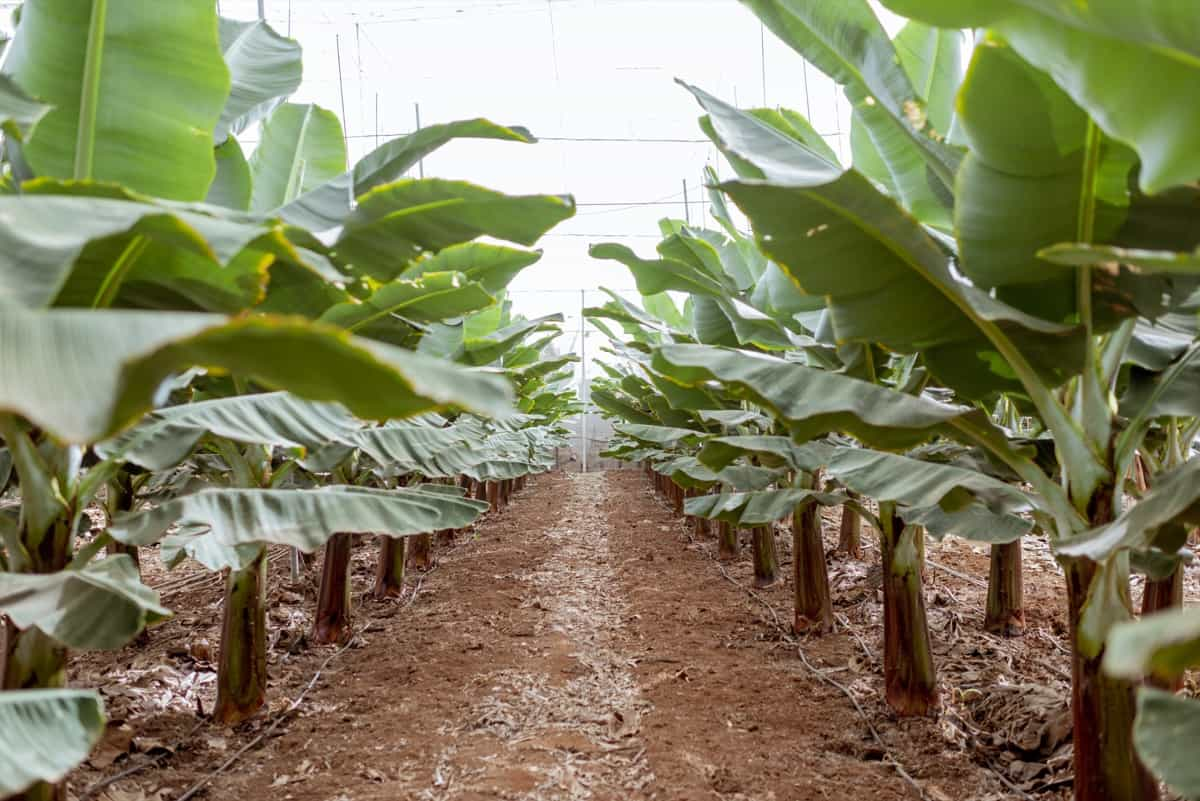The Banana Aphid, Pentalonia nigronervosa, belonging to the family Aphididae of the Order Hemiptera, is a major pest of banana plants worldwide. Banana aphids are small, soft-bodied insects that feed on banana leaves and stems, causing significant damage to the crop. The pest can transmit several viral diseases, including the Banana bunchy top virus, which can cause significant yield losses and reduce fruit quality.

Managing the Banana Aphids Pest is challenging, and several control measures have been developed to manage the pest, including chemical, cultural, and biological control methods. To effectively manage this pest, it is important to understand its life cycle, its preferred habitats, and the best methods for controlling it. This article will provide an overview and discussion of the Banana Aphids Pest in Banana crops, including its symptoms, identification techniques, and control.
Banana Aphids Pest Management
Life Cycle of Banana Aphids Pest in Banana Crop
The lifecycle of Banana Aphids Pest begins with the egg stage, where females lay their eggs on the underside of young banana leaves. The eggs hatch within 4-6 days, depending on environmental conditions. After hatching, the pest enters the nymph stage, which goes through four developmental instars, each characterized by different body shapes and colors. The nymphs feed on banana sap, causing significant damage to leaves and stem. The nymph stage lasts for about 12-14 days.
After completing the nymph stage, the pest enters the adult stage, reproducing and feeding on banana plants. The adult stage can last for several weeks, and females can produce up to 100 offspring during their lifetime. Banana Aphids Pest reproduces parthenogenetically, and females can give birth to live young, called nymphs. The nymphs go through several developmental stages before becoming adults and continuing the reproductive cycle. Around 40 generations are completed in one year.
Occurrence of Banana Aphids Pest in Banana Crop
- Location of Banana Aphids pest: This pest infests Banana crops in India, Africa, Sri Lanka, China, Thailand, Indonesia, the United States, Mexico, Brazil, Colombia, the Philippines, and Australia.
- Host range: The Banana Aphids pest infects crops like Bananas, Alocasia, Cardamom, Caladium, Ginger, Colocasia, Heliconia, and Taro.
Factors Favoring the Population Increase of Banana Aphids Pest in Banana Crop
- The pest prefers warm temperatures for growth and reproduction. The optimal temperature for pest development is between 25-30°C. The pest development retards above 35°C, while the pest becomes dormant below 15°C.
- The pest thrives in humid conditions. The optimal relative humidity for pest growth is between 60-90%.
- The pest prefers to feed on plants in shaded areas rather than in direct sunlight. So, they prefer plantations with dense canopies.
- The pest is more active during the rainy season, providing optimal pest development and reproduction conditions.
- The pest reaches its peak population level in dry, warm conditions in February, March, and April.
In case you missed it: Banana Rhizome Weevil Pest Management: Symptoms, Treatment, Chemical, Biological, Natural, and Organic Control

Identification of Banana Aphids Pest in Banana Crop
- Eggs: The eggs are usually pale yellow or green and are oval-shaped, measuring about 0.4 mm long.
- Nymphs: The nymphs have antennae and are reddish brown.
- Adults: The adult banana aphids are about 1-2 mm long, brownish, with black-veined wings and piercing and sucking mouthparts.
Damage Symptoms of Banana Aphids Pest in Banana Crop
- The aphids dwell in colonies on the pseudostems and the leaf axils.
- The pest acts as a vector for Banana Bunchy Top Virus.
- The leaves will be narrow, stunted, and bunched into rosette formation on the plants giving a bunchy top appearance of the crowns.
- The leaf margins roll upwards and show wavy margins.
- The pest prefers young, tender leaves as they are easier to penetrate and contain more sap for feeding.
Percentage of Yield Loss in Bananas Due to Banana Aphids Pest
- In India, the yield losses due to Banana Aphids pests are 20%. In Thailand, the percentage of yield loss is 30%. In Sri Lanka, the losses are 30%. In Indonesia, the losses are 25%. In Africa, it is 50%. In the United States, it is 20%. In Mexico, it is 30%. In Brazil, it is 40%. In China, it is around 20%.
- In Colombia, the losses are 50%. In Australia, it is 30%. In the Philippines, the yield losses are 40%. The Economic Threshold Level (ETL) for the Banana Aphids pest is set at 10-20% crop infestation.
Cultural Control of Banana Aphids Pest in Banana Crop
- Rotating the banana crop with other non-host crops can help to break the pest’s lifecycle and reduce pest build-up.
- Mulch helps to maintain soil moisture and temperature; this creates an environment that is less favorable for the pest.
- Pruning infested leaves and shoots can help to reduce the number of aphids present and prevent the spread of the pest.
- Over-irrigation can create a humid environment favorable for the pest, while under-irrigation can stress the plants, making them more susceptible to infestations.
- Proper sanitation practices like removing and destroying infected plant debris and weeds and regular disinfecting of pruning tools and equipment can help prevent the build-up of pest populations.
Biological Control of Banana Aphids Pest in Banana Crop
- Predators such as ladybugs, bean moths, green lacewings, and syrphid flies are attracted to companion plants that provide shelter and habitat. They feed on the pest and can help to reduce their populations.
- Parasitoids such as parasitic wasps lay their eggs inside the pests’ bodies, killing them.
- Fungal pathogens such as Beauveria bassiana and Metarhizium anisopliae can infect and kill Banana Aphids.
- Bacterial pathogens such as Bacillus thuringiensis and Pseudomonas fluorescens can be used to control the pest.
Chemical Control of Banana Aphids Pest in Banana Crop
- Spray insecticides on the crops like Imidacloprid, Thiamethoxam, Clothianidin, Abamectin, Methyl Demeton, Monocrotophos, or Dimethoate on the crown and at the base of the pseudostem.
- Spray insect growth regulators like Buprofezin and Pyriproxyfen.
- Injection – Inject Monocrotophos into the pseudostem at 45-day intervals from the third month up to flowering.
In case you missed it: Banana Pseudostem Borer Pest Management: Symptoms, Treatment, Chemical, Biological, Natural, and Organic Control

Organic Control of Banana Aphids Pest in Banana Crop
- Plant extracts from neem, garlic, ginger, turmeric, and chili can be applied to manage the infestation.
- Essential oils such as peppermint, clove, and thyme have insecticidal properties and are used to control Banana Aphids.
- Soap sprays are natural insecticides that can control aphids by dehydrating them.
Preventive Measures for Control of Banana Aphids Pest in Banana Crop
- Plant healthy pest-free suckers and resistant varieties to prevent pest incidence.
- Intercropping banana crops with other crops, such as legumes and vegetables, can help deter the pest by the scent of certain companion plants or may be preyed upon by beneficial insects attracted to the intercropped plants.
- Monitor the crops regularly to identify pest infestation in the early stages to keep it under control.
Conclusion
The Banana Aphids Pest, Pentalonia nigronervosa, is a major pest that causes significant damage to banana crops globally. Managing this pest can be challenging due to its rapid reproductive capacity and ability to transmit viral diseases. Implementing an integrated pest management approach that combines cultural, biological, chemical, and preventive control measures can reduce the reliance on pesticides and minimize the environmental impact of pest management practices.
- Deworming Schedule for Dogs/Puppies: A Beginners Guide
- How to Prevent and Control Parasites in Goats
- Beneficial Insects in Pest Management
- Natural Solutions for Pest Control in Flower Gardens
- Types of Fungicides Used in Agriculture
- Common Issues in the Fruit Development Stage of Pomegranate Farming
- Fruit Development Issues in Papaya: Easy Solutions and Treatment
- Soil-Borne Diseases and How to Protect Your Plants
- Practices to Prevent Disease Spread in the Garden